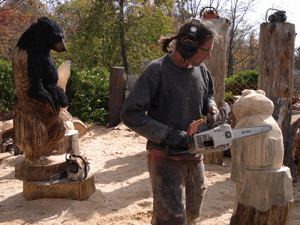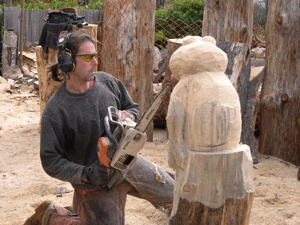A Man and His Chainsaw
Air Date: Week of September 3, 2010

Ken Packie sculpting. (Photo: Laurie Sanders)
Ken Packie knows how to wield a chainsaw. At his Berkshires, Massachusetts studio, he uses it to create works of art from big chunks of wood. Producer Laurie Sanders reports on this chainsaw sculptor extraordinaire.
Transcript
YOUNG: Chainsaws are pretty rugged instruments. Good for cutting firewood and clearing fallen trees, very useful as horror movie props. But not something you typically think of as an implement of art. And yet, Producer Laurie Sanders brings us the story of a man who carves out a living as a chainsaw artist.
[WHIRRING CHAIN SAW]
SANDERS: In the last ten years, chainsaw carving has come a long way.
PACKIE: I mean, it’s really being looked at as art and not as carnival carving.
SANDERS: Ken Packie is a full-time chainsaw carver in Otis, MA. He says because of national and international competitions, chainsaw carving has gotten much more sophisticated.
PACKIE: The realism and the form, it’s just gotten so good. In Germany and Japan you have a lot of classically trained artists who have gone to the chainsaw.
SANDERS: Packie is among an elite, new breed of chainsaw sculptors. Watching him is mesmerizing. He wields a chainsaw with speed and grace and accuracy. As he slices and shaves, the log in front of him is transformed into something else. Today he’s working on a life-size bald eagle.
[CHAINSAW]

Ken Packie at work. (Photo: Laurie Sanders)
PACKIE: Eagles or any bird really, is challenging to get their feather layout right and get that sense of motion that they have. And I find the key, really, is a bit of randomness in the feather pattern. Some longer and shorter, some ruffled, splits in some because nothing is really ever perfect in nature.
SANDERS: And the logs Packie uses aren’t perfect either. They’re what most people would consider junk wood. Here at his shop on Route 23, Packie is surrounded by several piles.
PACKIE: The wood comes from home owners, local tree service guys, and from professional timber clearing companies. And this is the small pile. I have a landing out in Monterey with a lot of pieces about the size of that one and bigger, that this company had taken down, and they are just too big for the mills. So the tree guys will bring it right here.
SANDERS: Most often Packie uses white pine. It doesn’t dry and split as much as the hardwoods, and he can easily get big trunks, which he likes to work with.
Now, before going any further, you should know that Packie never touched a chainsaw until a few years ago. He’s spent most of his career working as a telecom technician in New York City and Washington DC. He moved to western Massachusetts a few years ago to start work with a new telecom firm, and around that time he and his wife went to a home show where he saw someone chainsaw carving.
PACKIE: And it just got filed away as something to try. And another year went by and in October of 2005, I decided to go ahead and try it. But being from Jersey and never using a chainsaw, I thought it was best to get lessons. So I found somebody out in Washington state giving a three-day class, and I got hooked immediately. I realized I could see in 3-D. I could see where I was supposed to be going, I could see what should be coming off. I wish I would have discovered this 20 years ago. You know, as soon as I took that class, I knew right then, this is what I should be doing.

Ken Packie sculpting. (Photo: Laurie Sanders)
SANDERS: He started small. Whenever he had a free moment from work, he would carve. He took vacation days to carve. He met other carvers. Now he can carve almost anything, but his preference is realistic carvings of local wildlife. To get the proportions right, Packie says he looks at lots of photographs. Side shots, head shots, the length of the forearms. The relationship between the eyes, nose and skull. But when he carves, there’s never a measuring tape. It’s all done by eye.
PACKIE: I guess I’m trying to honor, in a way, in the individual animals by replicating them as real as possible and capturing part of what an eagle does here feeding, swooping down feeding. I’m trying to capture a snapshot of an animal for people who may not spend time out on a lake, looking for it to happen, for them to enjoy.
SANDERS: And where do these ideas come from? Just from his head.
PACKIE: Some carvers say there’s something definite in there and they’re just bringing it out. And it doesn’t work for me like that. I mean, I have the ideas in my head. A split piece like this one, I look at that and I can see maybe two otters, spiraling down, chasing a fish down here at the bottom. There could be a couple of owls, or a hawk sitting down here with two crows giving him a hard time.
SANDERS: After getting the piece close to where he wants it, he says the next step is to burn it with a torch.
[SOUND OF TORCH]
PACKIE: I refer to what I do as using chainsaws, chisels and fire to create what I create. And fire is the fun part. It’s doing two things: it’s cleaning up all of this furring that you see that you develop with the chainsaw. It cleans that up a little bit, and it’s providing a little bit of shading.
SANDERS: He uses sanders and other equipment for the fine details.
PACKIE: When I get to the eyes and some of the face details, I like to use hand chisels. I like to turn everything off, and it’s quiet, and then you can really get exactly the tilt of the eye, and get the lid the way you want it, and you can really get the expression you’re looking for by using chisels.
[SOUND OF CHISELS]
SANDERS: Packie’s work is considered so good that in 2009, he was recognized by United Chainsaw Carver’s Guild as its “emerging artist of the year.” This year, he’s been selected to participate in several invitation-only chainsaw sculpting competitions. And not only here in the US, but also in Canada, England, Scotland, Germany and Japan. For Living on Earth, I’m Laurie Sanders.
Links
Living on Earth wants to hear from you!
Living on Earth
62 Calef Highway, Suite 212
Lee, NH 03861
Telephone: 617-287-4121
E-mail: comments@loe.org
Newsletter [Click here]
Donate to Living on Earth!
Living on Earth is an independent media program and relies entirely on contributions from listeners and institutions supporting public service. Please donate now to preserve an independent environmental voice.
NewsletterLiving on Earth offers a weekly delivery of the show's rundown to your mailbox. Sign up for our newsletter today!
 Sailors For The Sea: Be the change you want to sea.
Sailors For The Sea: Be the change you want to sea.
 The Grantham Foundation for the Protection of the Environment: Committed to protecting and improving the health of the global environment.
The Grantham Foundation for the Protection of the Environment: Committed to protecting and improving the health of the global environment.
 Contribute to Living on Earth and receive, as our gift to you, an archival print of one of Mark Seth Lender's extraordinary wildlife photographs. Follow the link to see Mark's current collection of photographs.
Contribute to Living on Earth and receive, as our gift to you, an archival print of one of Mark Seth Lender's extraordinary wildlife photographs. Follow the link to see Mark's current collection of photographs.
 Buy a signed copy of Mark Seth Lender's book Smeagull the Seagull & support Living on Earth
Buy a signed copy of Mark Seth Lender's book Smeagull the Seagull & support Living on Earth

